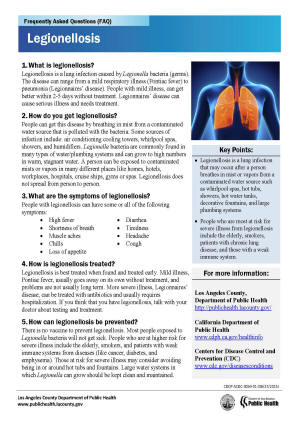Legionellosis

Legionellosis is a bacterial infection with two distinct clinical forms:
1) Legionnaires’ disease (LD), the more severe form characterized by
pneumonia, and 2) Pontiac fever, an acute-onset, self-limited flu-like
illness without pneumonia. Legionella bacteria are common inhabitants of
aquatic systems that thrive in warm environments. Ninety percent of
cases of LD are caused by Legionella pneumophila serogroup 1, although
at least 46 Legionella species and 70 serogroups have been identified.
Transmission occurs through inhalation of aerosols containing the
bacteria or by aspiration of contaminated water. Person-to-person
transmission does not occur. The case fatality rate for LD ranges from
5% to 30%, but can be higher in outbreaks occurring in a hospital
setting. Most cases can be treated successfully with antibiotics and
healthy people usually recover from the infection. People of any age may
get LD, but the disease most often affects middle-aged and older
persons, particularly those who are heavy smokers, have chronic lung
disease, or whose immune systems are suppressed by illness or
medication. Symptoms may include malaise, fever, headaches, muscle
aches, chills, nonproductive cough, and pneumonia. Multi-system
involvement includes diarrhea, changes in mental status, hyponatremia,
and abnormal kidney and liver function tests. Diagnostic tests are by
culture of respiratory secretions and/or tissue, urine antigen testing,
direct fluorescent antibody (DFA) stain of lung tissue or sputum,
serologic testing by IFA. LD incidence is usually found in the summer
and early fall, but can happen any time of the year. Each year between
8,000 and 18,000 people are hospitalized with Legionnaires disease in
the U.S. However, many infections are not diagnosed or reported, so this
number may be higher. According to the CDC, cases of Legionnaire’s
disease in the U.S. have tripled in the past decade.
In January, 2011, the CDC has added
Legionella to the Active Bacterial Core Surveillance project, a
population-based effort for testing clinical specimens for a range of
bacterial pathogens. This is in collaboration with state health
departments to identify the reasons for the rising number of Legionella
cases.
|
2018
Skilled
Nursing
Facilities
Symposium
on
Managing
Legionnaires'
Disease
|
|
Presentation Archive
(Full
Recording/Video
HERE)
|
Additional Resources


